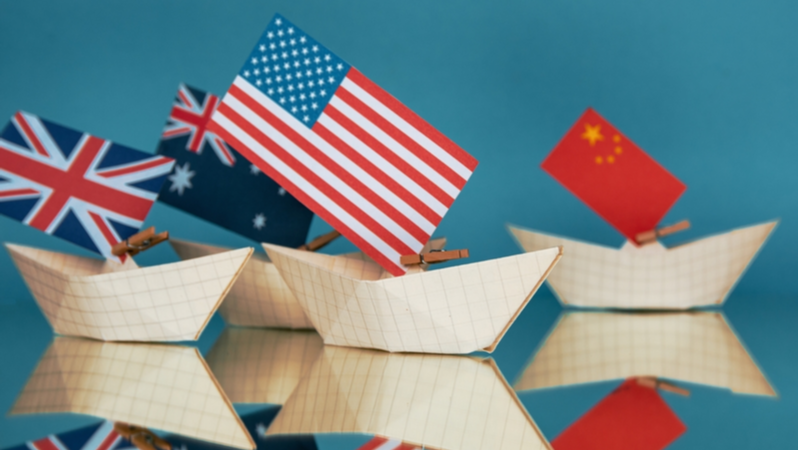By standing up to China, Australia may end up standing alone
October 14 2021

Note: This article appeared in Fortune on October 14 2021.
Earlier this month, with great fanfare, Washington, London, and Canberra announced the AUKUS pact: a security arrangement meant to confront China. The deal was hailed as a 'historic opportunity’ by Australian Prime Minister Scott Morrison ‘to protect shared values and promote security and prosperity in the Indo-Pacific region.'
As the US-China strategic rivalry intensifies, no other capital in the Asia-Pacific region has exceeded Canberra’s gumption in backing Washington, as well as trying to rally others to the cause. Security arrangements like the AUKUS deal might imply that these efforts are paying off, as America strongly supports Canberra’s efforts as relations with China worsen.
But the realm of trade tells a more complicated story. Canberra’s handling of superpower relations has provided a cost-free lesson for those elsewhere. Australia is the starkest example of a dilemma all countries in the region face: relying on China for economic growth, yet on the United States for security. Canberra’s choices reveal the mistakes behind a mindset that regards suffering economic repercussions for ‘standing up to China’ as a badge of honor—and how a country that takes such an approach would likely stand alone, pundit plaudits aside.
Australia’s tilt against China began in the second half of 2016. But for the most part, Beijing limited its displeasure to the diplomatic realm. The last time a leader’s visit took place was in March 2017, and ministerial-level visits were few and far between.
This changed in April 2020 when Australian political leaders conveyed a distinct impression of coordinating with the Trump administration to attack China over the COVID-19 pandemic.
Beijing unleashed a campaign of trade disruption that now affects around a dozen Australian exports—everything from coal to wine.
Despite local boosters of Canberra’s ‘crazy-brave’ approach emphasizing that officials in Tokyo and New Delhi have issued joint statements with Canberra ‘opposing coercive economic practices,’ neither Tokyo nor New Delhi were prepared to even confront China by name.
Indonesia, the indisputable center of economic and strategic gravity in Southeast Asia, declined altogether to sign up to any reference to economic coercion.
The fact is that plenty of capitals have serious concerns about China’s behavior under President Xi Jinping and have far more serious direct disputes with Beijing than does Canberra. But few appear convinced that the Australian government’s approach is preferable to a strategy of cautious hedging.
And why would they be?
Australia is now an outlier in having no senior political dialogue with China and in the breadth of trade disruption it is experiencing.
In June, Singapore Prime Minister Lee Hsien Loong delivered pointed remarks while standing alongside Prime Minister Morrison at a joint press conference: ‘There will be rough spots [with China]…and you have to deal with that…But deal with them as issues in a partnership which you want to keep going and not issues which add up to an adversary which you are trying to suppress.’
The region also hasn’t missed that while US Secretary of State Antony Blinken, insisted in May that the United States ‘will not leave Australia alone on the field,’ Washington has yet to show any interest in bearing a cost to make good on that promise.
In March, the acting US ambassador in Canberra, Mike Goldman, cheered Australia on: ‘I’d just say keep on doing what you’re doing but with confidence that the United States and other like-minded democracies see an interest in having Australia succeed.’ Yet when presented with the latest trade data showing American companies were exporting more commodities to China, filling the gap left by barred Australian imports, the US embassy declined to comment.
Six months after White House coordinator for the Indo-Pacific Kurt Campbell insisted that the US was ‘not prepared to improve relations’ with China so long as Australia was being hit with trade attacks, US Commerce Secretary Gina Raimondo is now talking up increased trade with China: ‘It’s just an economic fact. I actually think robust commercial engagement will help to mitigate any potential tensions.’
After an eight-month review of the US-China trade relationship, this week the US Trade Representative, Katherine Tai, announced that the Biden administration was striving for a ‘recoupling’ rather than decoupling. She said her intention was to advance this agenda and tackle ongoing US concerns through direct dialogue and negotiations with the Chinese side.
Meanwhile, Australia’s trade minister, Dan Tehan, has not been able to secure even a phone call with his counterpart in Beijing since he took on the portfolio in December last year.
Ambassador Tai also emphasized that enforcement of the Phase One deal the Trump administration struck with Beijing in January 2020 was a priority. This deal contained numerous Chinese commitments to purchase American goods, putting producers in Australia at an unfair disadvantage.
To be clear: None of this excuses or deflects attention away from Beijing’s bad behavior toward Australia. And, for its part, Washington’s support for American producers and households is exactly what one should expect.
As Michèle Flournoy, a former senior Clinton and Obama administration official, stated last month: ‘I’m not sure that the White House can control Napa Valley exports of wines to China.’
This complicated balance is well understood in Australia’s region. The one exception, perhaps, is Canberra.
Professor James Laurenceson is Director of the Australia-China Relations Institute at the University of Technology Sydney.

